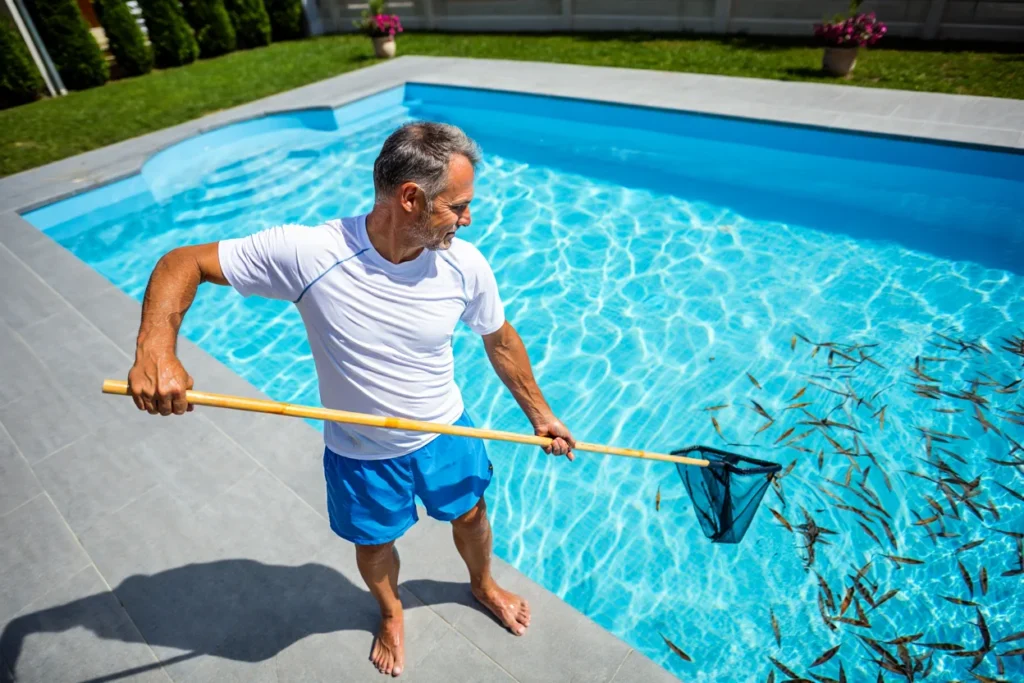Preparing your pool for spring is the first step towards enjoying the sunny days and the imminent swimming sessions. After winter, your pool deserves some attention to ensure it’s ready to welcome you.
How can you smoothly transition from winterization to swimming with peace of mind? Read on to discover the essential steps and practical tips for a successful pool restart.
When to restart your pool?
As soon as the first spring sunshine breaks through, we already dream of lounging in crystal-clear water. However, be cautious not to delay too long.
It’s highly recommended to start early, as soon as the water temperature is between 12°C and 15°C. Why? To prevent algae and bacteria from proliferating, which begin to develop as soon as the water reaches 12°C.
Typically, the best months to reactivate your pool are March and April. There’s no need to wait longer; delaying the opening of your pool until June will not save you money. On the contrary, water that has “turned” due to lack of care can incur significant costs to recover.
Reinstalling equipment: a necessary step
First things first, it’s time to tidy up and set up the equipment. This spring, you must absolutely remove the following winter components:
- Winter cover (and associated floats)
- Winter plugs and gizmos
Next, install the usual accessories removed during winter, such as return jets, skimmer baskets, and the clean, ready filter.
Restarting based on your winterization method
The tasks necessary to restart your pool vary depending on the type of winterization chosen: active or passive.
Easy start after active winterization
During an active winterization, your pool continues to function slowly throughout the winter. The result? The spring restart is made easier.
Simply check the pH, adjust the daily filtration duration, and carry out a light cleaning session: you’ll be ready for swimming in no time!
Start after passive winterization
If you opted for passive winterization, completely stopping filtration and equipment, you’ll need to put in some extra effort upon reopening. Here’s how to proceed:
- Completely remove winter equipment (cover, floats, plugs).
- Thoroughly clean the pool and its immediate surroundings.
- Manually eliminate large debris to make subsequent filtration easier.
- Carry out a meticulous descaling and reinstall your filter.
- Top up the water level to achieve the optimal height.
- Check the water quality by performing a thorough disinfection treatment (chlorine, bromine, or active oxygen).
Finally, take the necessary time to let your filtration run for one to three days, so your water regains its clarity and sparkle for your first swims.
Tips for clear and healthy spring water
Whether you choose passive or active winterization, the goal remains the same: to have quality water as soon as you start up your equipment. Here are some practical tips to keep in mind:
- Avoid completely draining the pool each spring; this is unnecessary and wastes water and money. Water can be treated effectively without needing to be fully replaced.
- Conduct an appropriate shock treatment based on your usual maintenance method (chlorine, bromine, or active oxygen) after winter to eliminate particles and bacteria.
- Maintain good filtration at the beginning of the season to ensure the water becomes clear and pleasant as quickly as possible.
- Regularly check the pH levels, ideally once a week. For optimal comfort and healthy water, aim for a value between 7 and 7.4.
Final checks of equipment and pool
Before fully commencing your swimming season, take advantage of the restart to thoroughly inspect your pool. Check the walls, the bottom of your pool, and all your equipment for any cracks or defects that may have appeared during the winter.
If necessary, take the time to make any needed repairs now. This way, you’ll avoid unpleasant surprises in the middle of summer!
You’re now ready to get your pool up and running as soon as the first nice days arrive! What did you think of these tips? What type of winterization do you usually prefer for your pool? Share your experiences with us in the comments below. We’re eager to read your tips and personal experiences!

